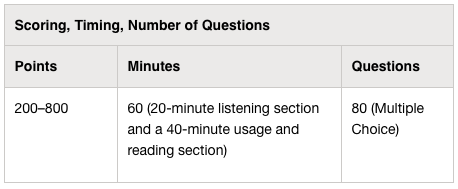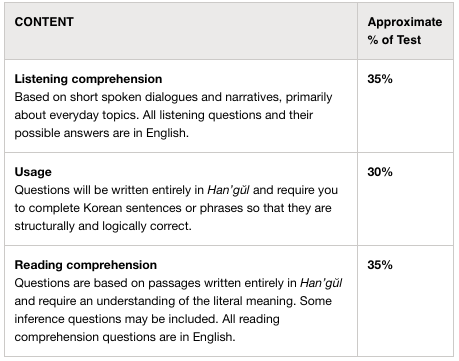Korean Education > SAT II Korean
> SAT II Korean
> Introduction
Do you understand both written and spoken Korean? Whether you learned the language inside or outside the classroom, the Korean with Listening Subject Test can help you showcase your achievements and enhance your college application. Some colleges may even allow you to use the test to fulfill basic language competency requirements or place out of introductory-level Korean courses, or both.
> Test Basics

> Gettign Ready for the Test
1) Anticipated Skills
- Ability to understand spoken Korean and identify what is being said in short spoken dialogues and narratives about everyday topics.
- Ability to complete sentences in a way that is structurally and logically correct, including vocabulary, honorifics, and various aspects of structure.
- Identify usage that is both structurally correct and contextually appropriate.
- Understanding of such points as the main and supporting ideas. Selections are drawn from authentic materials, such as notes, diaries, newspaper articles, advertisements, letters, and literary texts.
2) Recommended Preparation
- 2–4 years of study in high school or the equivalent
- Gradual development of competence in Korean over a period of years
- Review of sample listening questions using a practice CD that your counselor can order from the College Board
3) Topics on the Test

> Additional Things to Know
1) When should I take the Korean with Listening test?
There are a few factors to consider as you decide when to take the test. You should have at least two years of strong preparation in the language, but the more the better.
It's recommended that you take the Korean with Listening test as close to the end of the most advanced Korean class that you plan to take, while still balancing college admission and placement requirements. You’re likely not to do as well if you take the test after you haven’t been in a Korean class for several months.
- For seniors studying Korean: If Korean is a strong subject for you, be sure it’s one of the SAT Subject Tests you take in time for colleges to see your score. If you’re only taking it for placement purposes, and not as part of your application, wait until you’re as far along in your course as possible. If you want to take the Korean with Listening test, remember that it’s only given in November (and don’t forget to bring a portable CD player with earphones).
2) Which Korean is used on the Korean with Listening test?
The language used on the test is taken from pieces written and dialogue spoken by those who use Korean in their everyday lives. Words or sayings specific to certain geographic areas will not be used in the test. If you’ve had at least two years of strong preparation in the language, then you should be able to understand the Korean on the test.
3) I'm familiar with Korean but have not taken a class in school. Can I still take the Korean with Listening test?
No matter how you acquired your knowledge of Korean, it’s important to show colleges what you know. Bilingual (or multilingual) abilities are achievements that deserve to be highlighted. Your test will be scored the same way as that of someone who learned Korean in the classroom only. If you’ve been exposed to a lot of spoken Korean, then you should definitely consider taking the Korean with Listening test.
If you will be using these results to fulfill a college admission requirement, you should be aware that different colleges have different policies regarding Subject Tests in foreign languages. You should check with the colleges that you’re interested in about their policies and seek guidance from your counselor or teacher on your specific situation.
Please note that this test reflects what is commonly taught in high school. Due to differences in high school classes, it’s likely that most students will find questions on topics they’re not familiar with. This is nothing to worry about. You do not have to get every question correct to receive the highest score (800) for the test. Many students do well despite not having studied every topic covered.


